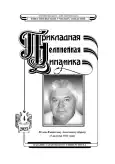Optimal balance of individual and collective in honeybee foraging
- 作者: Tereshko V.M1
-
隶属关系:
- Institute of Theoretical and Experimental Biophysics RAS (ITEB RAS)
- 期: 卷 31, 编号 4 (2023)
- 页面: 439-451
- 栏目: Articles
- URL: https://journal-vniispk.ru/0869-6632/article/view/250975
- DOI: https://doi.org/10.18500/0869-6632-003049
- EDN: https://elibrary.ru/VDDRLX
- ID: 250975
如何引用文章
全文:
详细
作者简介
Valery Tereshko
Institute of Theoretical and Experimental Biophysics RAS (ITEB RAS)
ORCID iD: 0000-0002-0303-8990
142290 Pushchino, Moscow Region, ul. Institutskaya, 3
参考
- Biesmeijer JC, de Vries H. Exploration and exploitation of food sources by social insect colonies: a revision of the scout-recruit concept. Behavioral Ecology and Sociobiology. 2001;49(2–3):89–99. doi: 10.1007/s002650000289.
- Corbet SA, Unwin DM, Prys-Jones OE. Humidity, nectar and insect visits to flowers, with special reference to Crataegus, Tilia and Echium. Ecol. Entomol. 1979;4(1):9–22. doi: 10.1111/j.1365- 2311.1979.tb00557.x.
- Moore D, Van Nest BN, Seier E. Diminishing returns: the influence of experience and environment on time-memory extinction in honey bee foragers. Journal of Comparative Physiology A. 2011;197(6):641–651. doi: 10.1007/s00359-011-0624-y.
- Dornhaus A, Chittka L. Why do honey bees dance? Behavioral Ecology and Sociobiology. 2004;55(4):395–401. doi: 10.1007/s00265-003-0726-9.
- Seeley TD. Progress in understanding how the waggle dance improves the foraging efficiency of honey bee colonies. In: Galizia C, Eisenhardt D, Giurfa M, editors. Honeybee Neurobiology and Behavior. Dordrecht: Springer; 2012. P. 77–87. doi: 10.1007/978-94-007-2099-2_7.
- Schurch R, Gruter C. Dancing bees improve colony foraging success as long-term benefitsoutweigh short-term costs. PLoS ONE. 2014;9(8):e104660. doi: 10.1371/journal.pone.0104660.
- Beekman M, Lew JB. Foraging in honeybees–when does it pay to dance? Behavioral Ecology. 2008;19(2):255–261. doi: 10.1093/beheco/arm117.
- I’Anson Price R, Dulex N, Vial N, Vincent C, Gruter C. Honeybees forage more successfully without the “dance language” in challenging environments. Science Advances. 2019;5(2):eaat0450. doi: 10.1126/sciadv.aat0450.
- Sherman G, Visscher PK. Honeybee colonies achieve fitness through dancing. Nature. 2002; 419(6910):920–922. doi: 10.1038/nature01127.
- Donaldson-Matasci MC, Dornhaus A. How habitat affects the benefits of communication in collectively foraging honey bees. Behavioral Ecology and Sociobiology. 2012;66(4):583–592. doi: 10.1007/s00265-011-1306-z.
- Dornhaus A, Klugl F, Oechslein C, Puppe F, Chittka L. Benefits of recruitment in honey bees: effects of ecology and colony size in an individual-based model. Behavioral Ecology. 2006;17(3):336–344. doi: 10.1093/beheco/arj036.
- Dechaume-Moncharmont FX, Dornhaus A, Houston AI, McNamara JM, Collins EJ, Franks NR. The hidden cost of information in collective foraging. Proc. R. Soc. B. 2005;272(1573):1689–1695. doi: 10.1098/rspb.2005.3137.
- Dreller C. Division of labor between scouts and recruits: genetic influence and mechanisms. Behavioral Ecology and Sociobiology. 1998;43(3):191–196. doi: 10.1007/s002650050480.
- Seeley TD. Division of labor between scouts and recruits in honeybee foraging. Behavioral Ecology and Sociobiology. 1983;12(3):253–259. doi: 10.1007/BF00290778.
- Calderone NW, Page Jr RE. Genotypic variability in age polyethism and task specialization in the honey bee, Apis mellifera (Hymenoptera: Apidae). Behavioral Ecology and Sociobiology. 1988;22(1):17–25. doi: 10.1007/BF00395694.
- Calderone NW, Page Jr RE. Effects of interactions among genotypically diverse nestmates on task specialization by foraging honey bees (Apis mellifera). Behavioral Ecology and Sociobiology. 1992;30(3–4):219–226. doi: 10.1007/BF00166706.
- Dreller C, Fondrk MK, Page Jr RE. Genetic variability affects the behavior of foragers in a feral honeybee colony. Naturwissenschaften. 1995;82(5):243–245. doi: 10.1007/BF01133602.
- Page Jr RE, Waddington KD, Hunt GJ, Fondrk MK. Genetic determinants of honey bee foraging behaviour. Animal Behaviour. 1995;50(6):1617–1625. doi: 10.1016/0003-3472(95)80015-8.
- Page Jr RE, Erber J, Fondrk MK. The effect of genotype on response thresholds to sucrose and foraging behavior of honey bees (Apis mellifera L.). Journal of Comparative Physiology A. 1998;182(4):489–500. doi: 10.1007/s003590050196.
- Seeley TD. The Wisdom of the Hive: The Social Physiology of Honey Bee Colonies. Cambridge, MA: Harvard University Press; 1995. 318 p.
- Theraulaz G, Bonabeau E, Denuebourg JN. Response threshold reinforcements and division of labour in insect societies. Proc. R. Soc. Lond. B. 1998;265(1393):327–332. doi: 10.1098/rspb. 1998.0299.
- Fewell JH, Bertram SM. Division of labor in a dynamic environment: response by honeybees (Apis mellifera) to graded changes in colony pollen stores. Behavioral Ecology and Sociobiology. 1999;46(3):171–179. doi: 10.1007/s002650050607.
- Visscher PK, Seeley TD. Foraging strategy of honeybee colonies in a temperate deciduous forest. Ecology. 1982;63(6):1790–1801. doi: 10.2307/1940121.
- Jones JC, Myerscough MR, Graham S, Oldroyd BP. Honey bee nest thermoregulation: Diversity promotes stability. Science. 2004;305(5682):402–404. doi: 10.1126/science.1096340.
- Beekman M, Gilchrist AL, Duncan M, Sumpter DJT. What makes a honeybee scout? Behavioral Ecology and Sociobiology. 2007;61(7):985–995. doi: 10.1007/s00265-006-0331-9.
- Johnson LK, Hubbell SP, Feener Jr DH. Defense of food supply by eusocial colonies. American Zoologist. 1987;27(2):347–358. doi: 10.1093/icb/27.2.347.
- Jaffe K, Deneubourg JL. On foraging, recruitment systems and optimum number of scouts in eusocial colonies. Insectes Sociaux. 1992;39(2):201–213. doi: 10.1007/BF01249295.
- Anderson C. The adaptive value of inactive foragers and the scout-recruit system in honey bee (Apis mellifera) colonies. Behavioral Ecology. 2001;12(1):111–119. doi: 10.1093/oxfordjournals. beheco.a000372.
- Tereshko V. Reaction-diffusion model of a honeybee colony’s foraging behaviour. In: Parallel Problem Solving from Nature PPSN VI. PPSN 2000. Vol. 1917 of Lecture Notes in Computer Science. Berlin, Heidelberg: Springer; 2000. P. 807–816. doi: 10.1007/3-540-45356-3_79.
- Tereshko V, Lee T. How information-mapping patterns determine foraging behaviour of a honey bee colony. Open Systems & Information Dynamics. 2002;9(2):181–193. DOI: 10.1023/ A:1015652810815.
- Tereshko V, Loengarov A. Collective decision making in honey-bee foraging dynamics. Computing and Information Systems. 2005;9(3):1.
- Loengarov A, Tereshko V. Phase transitions and bistability in honeybee foraging dynamics. Artificial Life. 2008;14(1):111–120. doi: 10.1162/artl.2008.14.1.111.
- Tereshko V. Kinetic phase transition in honeybee foraging dynamics: Synergy of individual and collective. Advances in Complex Systems. 2020;23(6):2050019. doi: 10.1142/S0219525920500198.
补充文件









